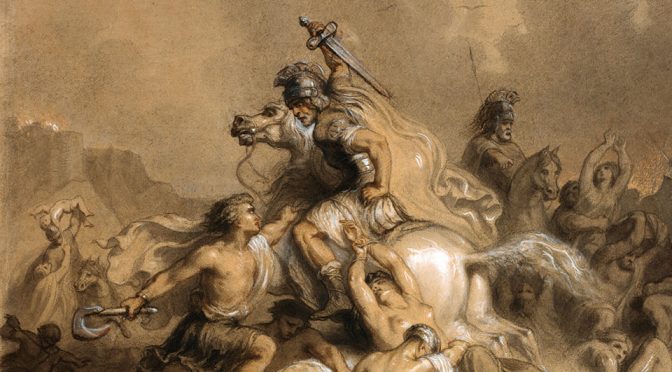A beautifully rendered church mosaic, a worn coin, a famous gold medallion — each bearing the images of men and women from Italy’s distant past. These representations were a common part of Prof. Massimiliano Vitiello’s Roman boyhood. But later, examining these same items with a scholar’s eye, Vitiello considered the stories behind these familiar faces and their place in Roman history.
Over time, Vitiello focused his research on Late Antiquity and the early Middle Ages (300-800 A.D.). Since coming to UMKC as a visiting professor in 2010, he has been promoted to associate professor of ancient history and late antiquity, and has devoted most of his studies to the barbarian invasions of the Roman Empire and their impact on the classical world.
For example, an unknowing reader might assume that Rome’s barbarian conquerors arrived with plans to reject and destroy Roman culture and learning.
“Typically, a conquering people would impose their social, cultural and civil standards on the vanquished,” Vitiello says. “This was not the case when the Goths came to power in Italy in the late fifth century. Despite these warring invaders who periodically seized power in Rome or established new seats of government, the preservation and continuation of Roman values were left intact.”
Vitiello’s fascination with the bonds of Germanic and Latin/Greek culture remains strong, because the modern Western world is the direct heir of this great cultural experiment.
“I’m sure this continuity contributed to the memory of Roman history surviving in the later empire, and to the shape of society as early medieval Europe was formed,” Vitiello says. “Indeed, the merger of societies and peoples in the Mediterranean world resulted in a diversity of cultures.”
Using Latin and Greek sources, Vitiello is filling in the blanks and reconstructing portions of lost works. In doing so, he hopes to resolve several significant questions: What led the so-called “barbarians” to assimilate and absorb Roman culture? How did this fusion create the world of medieval Europe?
Vitiello’s research is most rewarding when he recovers something that has been lost for so long. In a recent project, he was able to recreate and reconstruct details about the life and rule of an extraordinary woman, the Gothic queen Amalasuintha. It was exciting to find out how she was both positively and negatively represented by her contemporaries.
A current favorite of Vitiello’s and the subject of his forthcoming publication, Amalasuintha was from a political family, a king’s daughter who outlived her husband and manipulated her son during his brief rule, assuming the throne herself when he died.
“It was very interesting to see how a Germanic woman created an image that allowed her to hold political power equal to that of a Roman empress,” he says. “Germanic women were not taught to be leaders. As wives of rulers in parts of the former Roman Empire they were educated to reinforce their Christian virtues, not to prepare them to rule.
“There were powerful females during the transition from the Roman Empire to the Middle Ages; but they were the power ‘behind the throne,’ influencing their royal husbands or affecting the culture of his court. This makes Amalasuintha all the more unusual, as she ruled in her own right.”
Another of Vitiello’s current subjects is Theodahad, a Gothic “philosopher king” who much preferred the study of ideas to empire building. Theodahad is emblematic of a different kind of nobleman emerging in the sixth century. In general, Gothic warriors had a very martial education, but Theodahad was bookish and thoughtful.
A deeper examination of Vitiello’s work shows that, while there are not direct lines of contact, some modern leaders and would-be leaders have adopted a few of the ways of antiquity.
Then, works of art depicted rulers in both royal and religious garb. Now, politicians pose for pictures with the pope or the Dalai Lama. Then, lights, lamps and eyes were images of power, used as a metaphor for imperial rule. Now, we fear being scrutinized by our government, whose eyes and ears seem to be everywhere. Then, courtiers of Roman rulers wrote letters criticizing other hangers-on or even, on occasion, their own leaders. Now, political insiders get lucrative book contracts to spill secrets about the private lives of their superiors or other staffers.
Hawks or doves? Then as now, image is everything.

